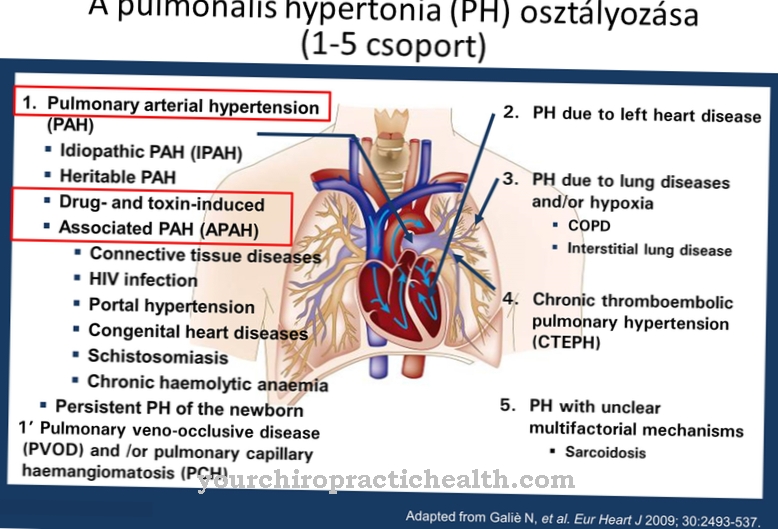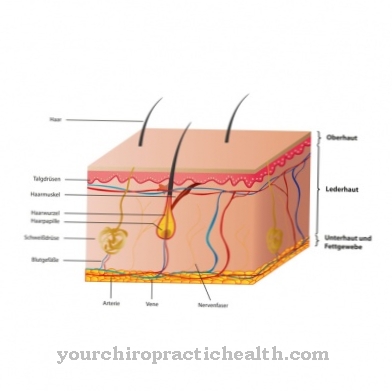Keratinocytes are horn-forming cells, which make up the majority of all cells in the epidermis (epidermis) at over 90 percent.
They are proliferated in the basal layer of the epidermis and migrate from the basal layer to the surface of the skin over the course of their approximately 28 days of life with ongoing production of keratin. Thanks to their interlocking, they give the skin firmness and form a protective shield against external influences.
What are Keratinocytes?
The name of the keratinocytes is derived from their ability to produce keratin or horny substance. They are continuously formed from basal stem cells that are located in the lowest layer of the epidermis, the stratum basale.
While they are slowly pushed towards the surface of the skin by subsequent cells in the course of their approx. Before they even reach the surface of the skin, they form cell extensions, so-called desmosomes, with which they interlock and thus form a protective shield that gives the skin its firmness and protects it from the ingress of water, chemicals, pathological germs and UV rays.
Until they reach the surface of the skin, the keratinocytes experience constant changes in shape and cell content. Just before the normal exfoliation process, which is ongoing, the cell completely loses its structure and cell membrane. It has developed from keratinocytes to cornecytes, to horn cells. Keratinocytes not only play a passive role as a protective barrier, but are also involved in inflammatory processes, active defense against germs and in the wound healing process and thus part of the active immune system.
Anatomy & structure
Keratinocytes undergo constant changes in shape and cell content in the course of their relatively short existence. Immediately after their formation from mitotic cell divisions of the epidermal stem cells in the basal layer of the epidermis, they begin to differentiate into keratinocytes.
They are fully equipped with a nucleus, cytoplasm, enclosed cell organelles and vesicles and have a cylindrical shape.In the granular layer (stratum granulosum) lying directly above the basal and prickly cell layers, the keratinization process and the dissolution of the cell nucleus proceed. Vesicles, which contain certain proteases, empty their contents into the cytoplasm, so that the nucleus and other cell contents are dissolved and metabolized. It is de facto a preprogrammed suicide of the cell.
The cells flatten more and more and the inside of the cells is gradually filled with keratin spheres, the keratin granules. Before the keratinocytes reach the outermost layer, the stratum corneum and the stratum disjunctim, they pass through the glossy layer, the stratum lucidum, which, depending on the region of the body, is strongly or only slightly pronounced. It is a thin boundary layer that is enriched with the special protein keratohyalin granules, which has a semi-liquid consistency and protects the skin from intruders and from drying out.
Function & tasks
The tasks and functions of the keratinocytes can be divided into mechanical-physical functions and biological-immunological tasks. In the top layer of the skin, the horny layer, keratinocytes are rightly named. They can no longer react to messenger substances because they have lost their cell nucleus and also the multitude of their organelles on their way from the.
Before they are sloughed off and “released” into the environment, the main task of the keratinocytes is to create the mechanical tear resistance of the skin, which is well achieved through the interlocking of the cells. In addition, the keratinocytes prevent the penetration of water or other liquids or the penetration of solid substances in the form of dust or pathogenic germs. On the other hand, they also prevent tissue fluid from escaping or the body from drying out unchecked due to the different vapor pressures between the body and the surrounding air. In their early stages, when keratinocytes still have an intact cytoplasm, they are part of the active immune response.
They are able to produce cytokines like interleukins and chemokines. In particular, by releasing TNF-alpha (tumor necrosis factor) and IL-1, the keratinocytes actively intervene in the immune response and in inflammatory processes. They mainly support the work of other cells in the immune system. The cytokines released when needed can also trigger systemic body reactions such as fever and other immune reactions. The keratinocytes even offer a certain protection against harmful UV radiation because they can absorb melanin-containing vesicles from melanocytes and protect their cell nucleus with the melanin they contain.
You can find your medication here
➔ Medicines against redness and eczemaDiseases
In addition to local inflammatory processes in the skin due to infections in the event of injuries and local skin changes, various types of skin cancer and systemic skin changes such as psoriasis are among the most important and most common skin diseases.
Basal cells, which constantly replenish the keratinocytes through mitotic divisions, can develop a so-called basalioma, a semi-malignant skin tumor that hardly metastasizes but can attack surrounding tissue such as bones and cartilage. Basalioma is the most common type of skin cancer. Actinic keratosis is caused by a local, uncontrolled increase in keratinocytes, which is usually expressed in reddish and rough areas of the skin. The disease represents an early form of spinalioma, the so-called sting cell cancer, which develops as a malignant tumor in the sting cell layer (stratum spinosum). Most facial cancer occurs in people over the age of 70.
For people who are affected by psoriasis, the disease is not immediately threatening, but can be very uncomfortable due to the visible skin changes. Several processes running in parallel lead to a four- to seven-fold increase in the rate of proliferation of the keratinocytes. The cells can no longer differentiate in the short time. In addition, there are most likely disorders of the immune system.
Typical & common skin diseases
- Vitiligo (white spot disease)
- skin rash
- Skin fungus
- Rosacea (rosacea)
- Systemic lupus erythematosus (SLE)
- Skin cancer

























.jpg)

.jpg)
